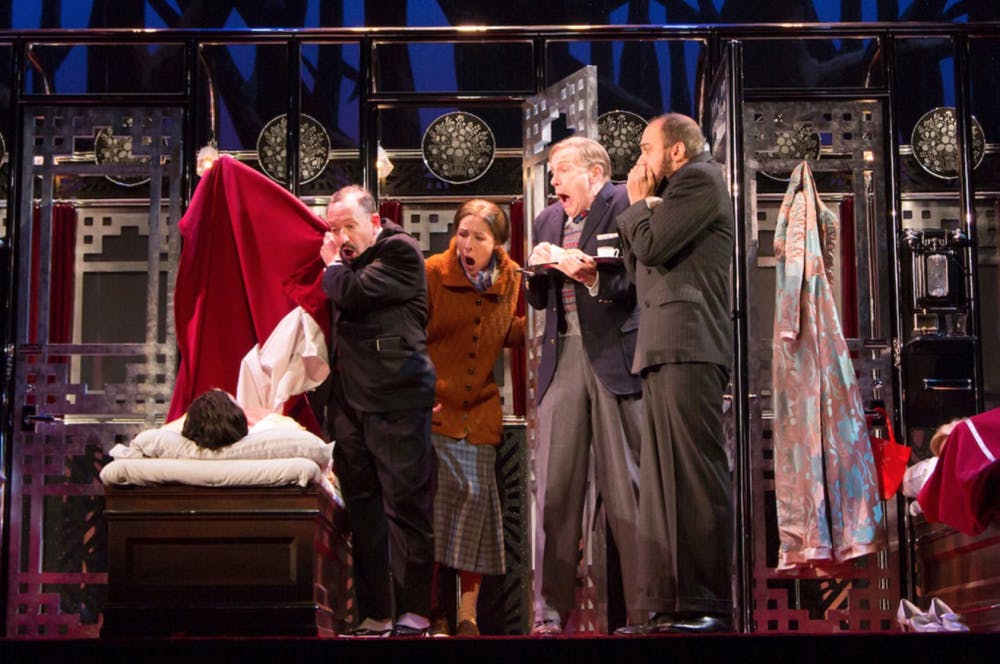“Murder on the Orient Express” begins with the murder of Daisy Armstrong, a five-year-old girl. The play launches its audience into a murder mystery with an incredibly dark, chilling moment: A silhouetted man breaks into Daisy’s room and then an abrupt blackout that leaves the child’s scream hanging in the air.
I was quite surprised, then, when the next two hours of the production felt fairly light-hearted and even comedic. The comic characters, such as the bitter old woman and the flamboyant foreign man, received countless laughs from the audience. These lighthearted “shticks,” however, took over the stage so much so that the play never managed to fully bring back its audience to the intensity of that opening scene.
In his opening monologue, detective Hercule Poirot introduces this case as one that makes him question all of his values. He returns to this grave tone in his closing monologue, in which he confesses that even though the case was resolved, for countless nights he has been unable to fall asleep until the sun rises. Yet, to me, this murder mystery did not feel haunting or chilling. It felt theatrical and fun, but ultimately very detached from any of the themes of justice, culpability, or loss that the original script conveys.
“Murder on the Orient Express,” based on Agatha Christie’s novel of the same name and adapted for the stage by Ken Ludwig, had its world premiere at the McCarter Theater on March 14 under the direction of Emily Mann. The story takes place in 1934, aboard the Orient Express train as it travels from Istanbul to Western Europe. After the five-year-old is found murdered in her room, detective Hercule Poirot, who is also aboard the train as a passenger, investigates the crime, slowly unraveling each clue and deciphering the mysteries behind each character, until he arrives at the shocking truth of the murderer’s identity.
The disclosure of this “shocking truth” was effective in the sense that it was definitely a plot twist that someone unfamiliar with the novel would not see coming. However, it didn’t feel quite as satisfying as it should have. This might have resulted from the fact that the clues leading up to this revelation were so cloaked in comedy that they didn’t feel particularly relevant, or because the characters felt underdeveloped and lacked contextualization: Even as the audience members were gradually made aware of certain secrets and mistaken identities, I still had trouble understanding or empathizing with each character’s “truth.” While the dots connected to reach an unexpected outcome, they didn’t connect in a way that I felt to be particularly moving, meaningful, or climactic.
One of the most interesting aspects of bringing a classic murder mystery to the stage is the opportunity to use dramatization and the performative nature of theater to heighten the suspense throughout the story so that the audience truly holds its breath as the pieces of the puzzle slowly piece together in real time. There were moments in this show when I laughed or felt surprised, yet none of these reactions seemed nearly as amplified as I think they could have been.
One aspect of the show that did feel exciting and intentional was Beowulf Boritt’s brilliant set design. Simulating the movement of the train by strategically utilizing the curtain and moving set pieces, his design beautifully captured the rhythm and atmosphere of the train, transporting the audience’s imagination into the play’s specific setting. Almost the entire show took place on the train set piece, and Boritt’s ability to make this space aesthetically pleasing and detailed, while accommodating the whole cast without feeling cramped, was truly incredible.
The show promotes itself as “eight suspects, one thrilling ride.” And while its comedic reins seemed to prevent it from truly reaching that thrilling summit, the ride was mostly entertaining, unpredictable, and beautifully situated.









